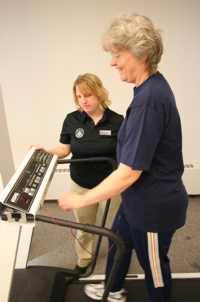

Before You Start > Safety
 Make safety a key concern when planning physical activity in your workplace. An accident or injury will not “sell” the program and may end up costing the employer. This section will help you take the necessary steps to avoid an accident or injury.
Make safety a key concern when planning physical activity in your workplace. An accident or injury will not “sell” the program and may end up costing the employer. This section will help you take the necessary steps to avoid an accident or injury.
Points to Consider
Using Certified Professionals
Hire professionally certified instructors to lead fitness classes (whether on or offsite) or to run workplace lunch and learn sessions.
In Alberta, check with the Provincial Fitness Unit about the instructor certifications required for the event or activity you’re organizing. It’s also a good idea to ask the instructor for references.
When you hire instructors, make sure that your insurance protects both the instructor and your organization.
Risk Management
Whether we like it or not, liability is an issue these days.
Risk management plans don’t have to be complicated or expensive. For example, part of the plan might require that employees complete fitness appraisals and sign statements accepting the possible risks involved in physical activity. It pays to be prepared. Safety and emergency policies and procedures reduce the risk of loss both to individuals and to your organization.
Ask employees to sign a waiver when participating in both onsite and offsite activities. For liability reasons, employees must understand the risks involved in participating in the activity and understand that they are waiving their right to sue.
The employee should not be asked to sign the waiver just before the activity. The waiver may be invalid if employees claim that they didn’t fully understand the risks.
Other Safety Tips
Here’s a list of some other safety tips to keep in mind when planning physical activity.
Look at the environment where employees are active:
-
Sidewalks should be clear of ice and snow, away from falling debris or snow, and have clearly marked curbs and safe crosswalks.
-
Stairwells should be well-lit and in good condition and have handrails and safety features, so that employees are not locked out of floors.
-
Fitness facilities should have proper flooring, good ventilation, and access to water and an emergency telephone.
Offer medical screening for employees participating in activities:
-
PAR-Q: This short questionnaire identifies people who should consult a doctor about the type of activity most suitable for them.
-
PAR-MEDX for Pregnancy: A checklist and prescription used by health care providers to evaluate pregnant women who want to enter a prenatal fitness program and for medical observation of pregnant women who are exercising.
Below are some other important safety factors:
-
First-aid kit and automated external defibrillator on site.
-
Emergency Action Plan (EAP) in place and practised.
-
Commercial grade fitness equipment (not donated, “hand me down” equipment).
-
Documented equipment inspection and maintenance schedule.
-
Orientation of equipment and programs done by certified professional with a physical activity background.
These are only a few examples of safety factors. Please visit the links below for more information.
Find out More
Sport Law & Strategy Group: A resource that provides information on waivers, the legal and ethical risks, guidelines for drafting waivers and alternative options.
Provincial Fitness Unit: This organization administers, certifies and supports Alberta fitness professionals. The Provincial Fitness Unit can help you identify qualified fitness leaders.
Workers’ Compensation Board: This not-for-profit organization provides a wide range of services and resources for employees, employers and health care providers.